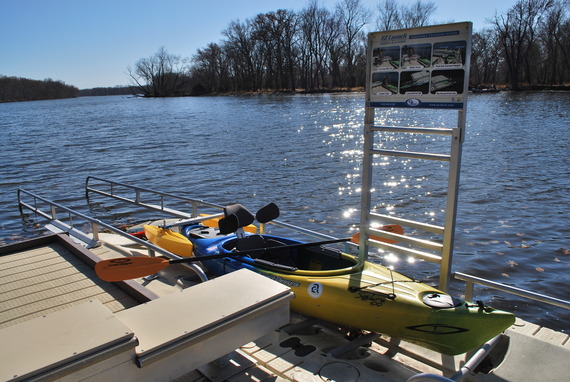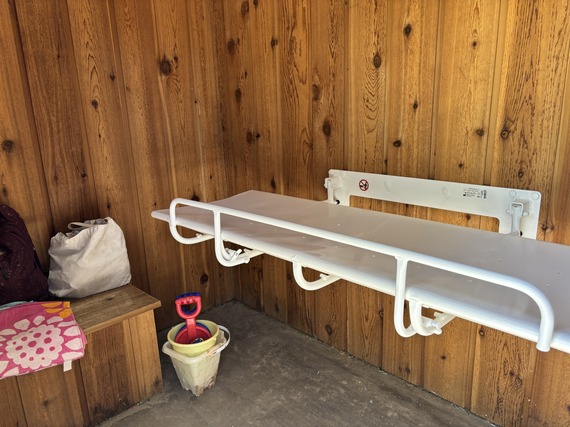DNR Parks And Recreation News
What’s Happening In Wisconsin's State Parks,
Forests, Trails And Recreation Areas
 Adaptive kayaks feature several adaptive devices that help paddlers of all abilities get started on their adventure. / Photo Credit: Wisconsin DNR
Paddle-Powered Fun For All With Adaptive Kayaks
Individuals of all abilities, including those with mobility impairments, now have a unique way to experience the outdoors. Adaptive kayaks feature several adaptive devices that help paddlers of all abilities get started on their adventure. These kayaks are available for use through the park’s canoe/kayak concessionaire and typical rental fees apply. It is recommended to call the park before your visit to make sure an adaptive kayak is available. The DNR is also adding universal kayak launches to some properties, starting with Merrick State Park.
Some of the available kayaks are tandem models with two seats (one standard seat and one adaptive seat) and can be used individually or with a partner.
Adaptive kayaks are currently hosted at these properties:
These adaptive kayaks are available for everyone and are a great option for new paddlers and people of all abilities, including people who need a more stable kayak for balance issues, ailments due to aging, etc. Whether you were a paddler before a disability or have never had an opportunity to get out on the water in a kayak due to physical limitations, summer is the perfect time to head to one of these state parks to give it a try.
The adaptive kayaks feature outriggers near the back of the kayak (adjustable to four different widths depending on the user's level of function), providing incredible water stability (although they can still tip, so use caution). A raised back with side supports also offers the user a comfortable and secure seat while paddling. Not only is this adjustable, but parts of the seat can be removed altogether for individuals with greater upper-body strength. The adaptive kayak paddle is equipped with hand braces that make paddling easier for individuals with limited grip.
Many of our kayaks also have a corresponding kayak chariot, a wheeled device that holds the adaptive kayaks. The chariot allows transfers on a flat, level surface (like a parking lot) by positioning the cockpit rim at wheelchair height. With the paddler(s) in the kayak, the rig can be rolled into the water and floated off the chariot, making most water entry points (like boat ramps) more accessible.
Outdoor News And Announcements
 Peninsula State Park now features a universal changing station at Nicolet Beach picnic shelter. / Photo Credit: Wisconsin DNR
Universal Changing Station At Peninsula State Park
We are excited to announce a new universal changing station at Peninsula State Park! This universal changing station has been installed in one of the changing rooms at the Nicolet Beach picnic shelter and is an important addition that increases accessibility and provides a safe place for individuals and families to take care of personal needs with dignity while at the park.
The universal changing station can be used by all, including children, adults and families of all abilities. This new amenity comes through a partnership with Michelle’s Action Angels, and we are excited to work together to provide this inclusive option at the park.
Nicolet Beach also features a universal playground, paved pathways to and around the beach area, a beach access mat and a beach wheelchair. These amenities, along with the new universal changing station, help provide accessible outdoor recreation options for visitors of all abilities at Peninsula State Park. For more information on accessible opportunities and amenities at the park, check out the Peninsula State Park accessibility webpage.
Property Highlight: Richard Bong State Recreation Area
 The Nature Explore Classroom is an outdoor, nature free-play space open to visitors of all ages, abilities and sensitivities. It is located directly behind the Richard Bong State Recreation Area visitor center and is free to use. / Photo Credit: Wisconsin DNR
Richard Bong State Recreation Area offers accessible opportunities including an accessible cabin, campsites, picnic shelters, fishing pier and boat launch, wildlife viewing platform, universal hunting blind and a nature center with an outdoor classroom. Additionally, the park has a beach access mat and features a universally accessible trail! For more information, visit our Accessible Recreation webpage.
In addition to the accessible cabin, there are two family (modern) campgrounds with a total of 217 campsites, including 54 with electric hookups. Six group campsites can accommodate 225 campers.
There are four different picnic areas at the property. All picnic areas have accessible picnic tables. Near the swimming beach, there are volleyball nets and a playground. There are also six reservable shelters and an amphitheater available for reservation. All shelters are reservable May – October.
The Molinaro Visitor Center is a great place to start your park adventure. Hands-on exhibits introduce you to the nature and history of the recreation area. Discover who Richard Bong was and why the park is named for him. View live animals. Crawl through a coyote den. See Potawatomi artifacts. Try dressing or living like the first pioneer family. A sun-filled solarium showcases rotating seasonal exhibits.
The Molinaro Visitor Center is also the spot to pick up directions for several self-guided adventures: Discovery Quest, Geology Adventure Quest, Orienteering Course, Water Trail and History Tour, as well as Wisconsin Explorer Books.
The property offers an area where visitors may fly model airplanes, rockets, hang gliders and hot air balloons. The property also has space to train both hunting and sled dogs, train falcons, ride all-terrain vehicles, off-highway motorcycles and horses, and hunt during open seasons. All such activities take place in the Special Use Zone or managed hunt areas. Activities in this area must be managed to ensure compatibility. Please call ahead at least a week before your planned event for permission to use the area.
Shore fishing is available on Wolf Lake and at the urban fishing pond. Wisconsin fishing licenses are required for anglers age 16 and older. Off-road biking trails are available on the trails north of Highway 142.
Lastly, the Friends group at Richard Bong State Recreation Area sells valuable and fun items to help you explore nature and remember your visit. Merchandise can be purchased at the entrance station or the visitor center when the buildings are open.

Upcoming Events
Edible And Medicinal Natives Of Lakeshore
Friday, July 11, 2024 at Lakeshore Lake State Park
6 – 7 p.m.
Although Lakeshore State Park might not look like a farm, a lot of our native plants are edible or medicinal.
Join our naturalist to learn more about these plants and their uses as we hike around the park.
All ages and abilities are welcome!
Meet at the north entrance, near Discovery World.
Cut Leaf Teasel Pull-A-Thon
Saturday, July 13, 2024 at Kettle Moraine State Forest - Northern Unit
9 a.m. – noon
Cut-leaf teasel is well established and spreading in surrounding areas. To date, cut-leaf teasel has only been seen in the Zillmer Trail Area and a few other sites in the forest, and past efforts show that it can be contained.
Please contact Connie Ramthun, Friends of the Kettle Moraine Invasives Coordinator, at connieramthun@gmail.com or 920-533-8939 with any questions.
Meet at the Zillmer Shelter, located at W833 County Rd SS, Campbellsport, WI 53010.
Note: We might travel to the town of New Fane on the second date.
Ink Fish Printing
Saturday, July 13, 2024 at Kohler-Andrae State Park
10 – 11 a.m.
“Gyotaku” (guy-yo-tah-koo), or ink fish printing, was originally a method of counting how many fish an angler caught. Try your hand at this ancient artform with help from our wonderful volunteers. Paper, bandanas and all supplies will be available; bring a T-shirt if you want to print one. All ages are welcome.
Meet at the Park Bathhouse near parking lot P6.
Bumblebee ID
Wednesday, July 17, 2024 at Horicon Marsh Education Center
5:30 – 7:30 p.m.
Join master gardener Jennifer Lazewski as we scan the flowers for native bumblebees.
Space is limited to 20 participants. It is a free program, but registration is required on the website.
Contact Liz Herzmann at 920-387-7893 or Elizabeth.Herzmann@wisconsin.gov for information.
Love this newsletter? Forward it to a friend! Help your friends and family stay up-to-date with news, highlights and events from the Wisconsin State Park System with our weekly OutWiGo Newsletter. To sign-up for weekly newsletters, visit the OutWiGo webpage.
|